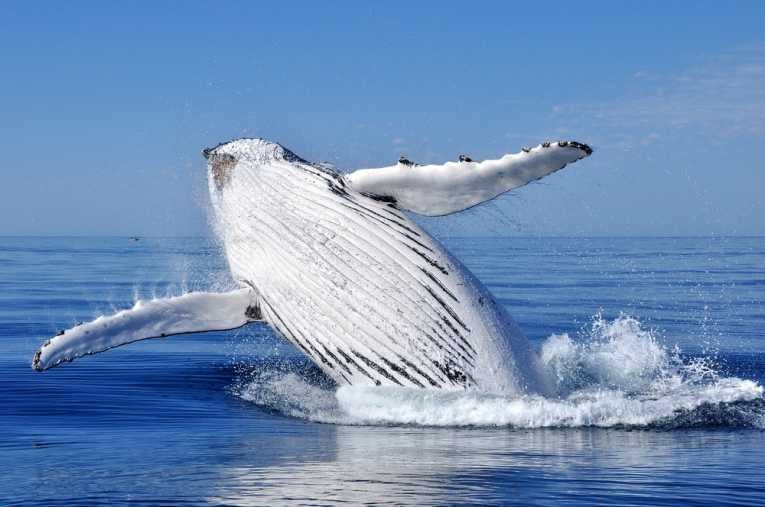The rorqual whales are generally those which share slim bodies, throat grooves and tiny dorsal fins. The atypical 56 foot (17m) humpback, on the other hand, is more like the huge blue whale. The broad, round head is certainly similar but the elongated flippers are certainly not. They take up a third of the body length and are scalloped in shape on the leading edge. One of the first recorded was found beached at the mouth of the River Elbe in 1846, and that is when the long-wing (Megaptera) name was given to the genus.
Again, unlike the elusive blue, humpbacks are often oblivious to humans or their boats. Covered in two species of Coronula barnacles when in cold waters, they perform characteristic back-flips for all the world to see. The whale louse, Cyamus, is found to replace the barnacles in tropical oceans. Megaptera has the exclusive use of this special ectoparasite. Northern hemisphere humpbacks eat shoaling fish such as capelin, anchovy and cod, pods of three or four being known to follow trawlers to catch the spill.

Humpbacks feeding using the bubble net method; Credit: James Pilkington
In Alaska, the famed bubble net is used to concentrate the fish, with size of bubbles probably suited to the size required by the prey. They feed at the surface or rushing to the surface to scoop the prey in the baleen. Southern hemisphere humpbacks eat crustaceans such as krill. During their winter in the tropics, these whales fast, living off body fat.
Signalling is a significant part of this animal's repertoire. Whether the huge raised flipper, or the powerful tail, warning "shots" can be fired off by individuals who want to warn the pod of danger. Underwater, too, Judy Collins (famous singer) has used the long and intricate and varied whale song in her own repertoire. Short sound units are combined into musical phrases that form unbroken, 10-15 minute songs. These are the longest and most varied vocalisations in the animal world. Humpbacks regularly keep loosely connected across hundreds of kilometres with the possibility that the whole NW Atlantic Ocean is one big humpback social site.

Mother and calf (calf is approx. 8m long) via Shutterstock
Quick-maturing, the humpback mates face-to-face after playful courtship in shallow bays. We'd like to show you a picture of that, but regulations could forbid such visions. We'll leave that particular picture to your vivid imagination. After almost a year's gestation, there is commonly a two parent system. The "third" whale maybe a male or sometimes a female escort, although with mating likely after the birth, the former may be more common. Either way, the baby gets extra protection from the orcas and other possible threats. Nowadays, many could live to 100 years old. As the best known baleen whale, we still have no idea how their social complexities become established.
Scientists believe that a lone male will begin the notorious song cycle in the breeding season, leading to a pop song for the year that incorporates pieces of the locale's previous songs. Whether sexual display, family orientation or simply "joy," science simply can't cope with these 80,000 songsters. Most are in the north Atlantic, migrating generally to the tropics in winter. They are endangered to some extent, but only in certain areas such as the Arabian Sea and the NW Pacific. Certainly not endangered are certain whales known to whale watchers. Perhaps only humpbacks among the large whales could have well-known personalities such as Migaloo (an albino) in eastern Australia and Humphrey in San Francisco Bay.










